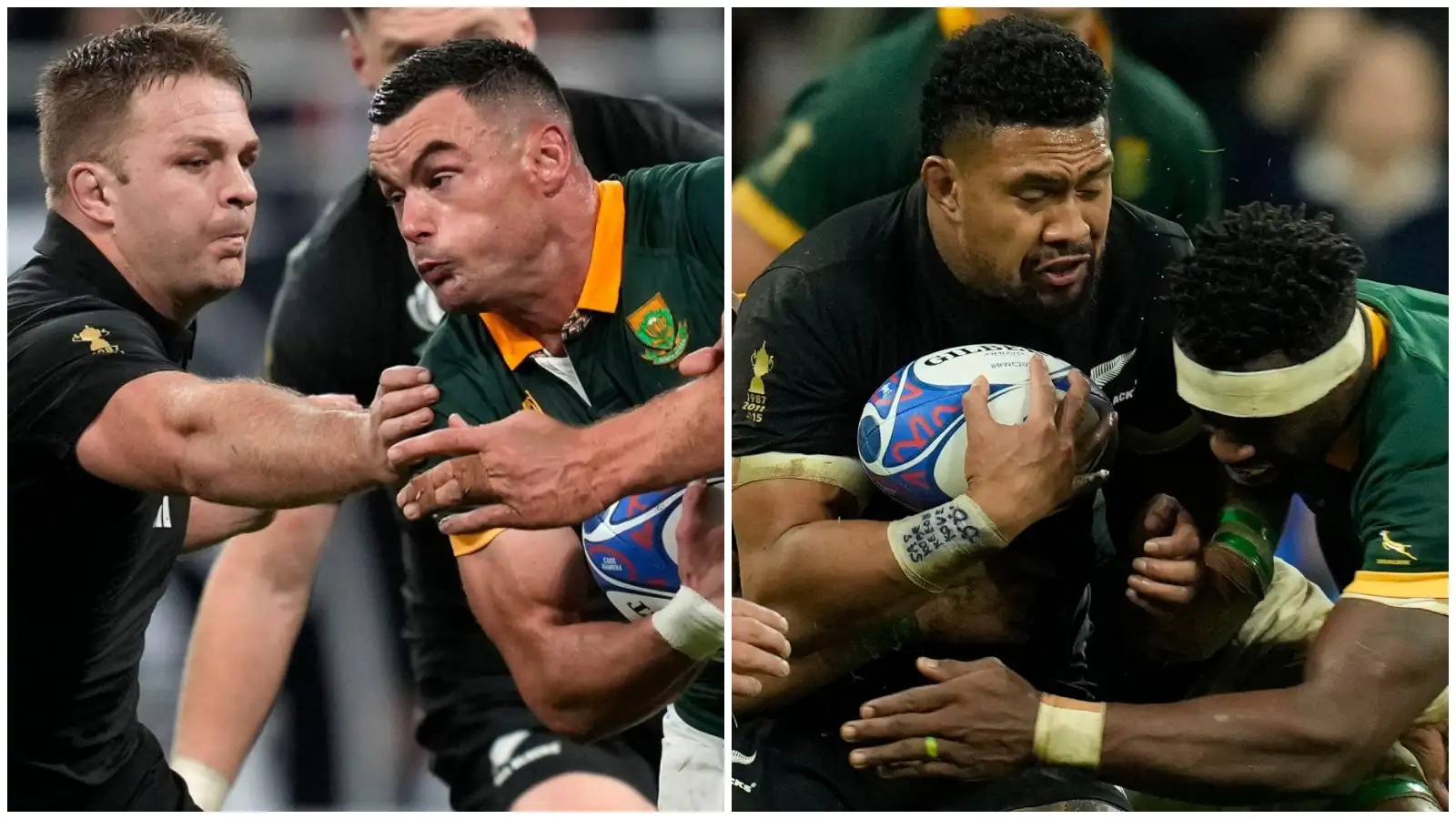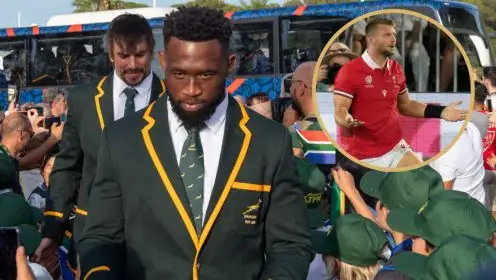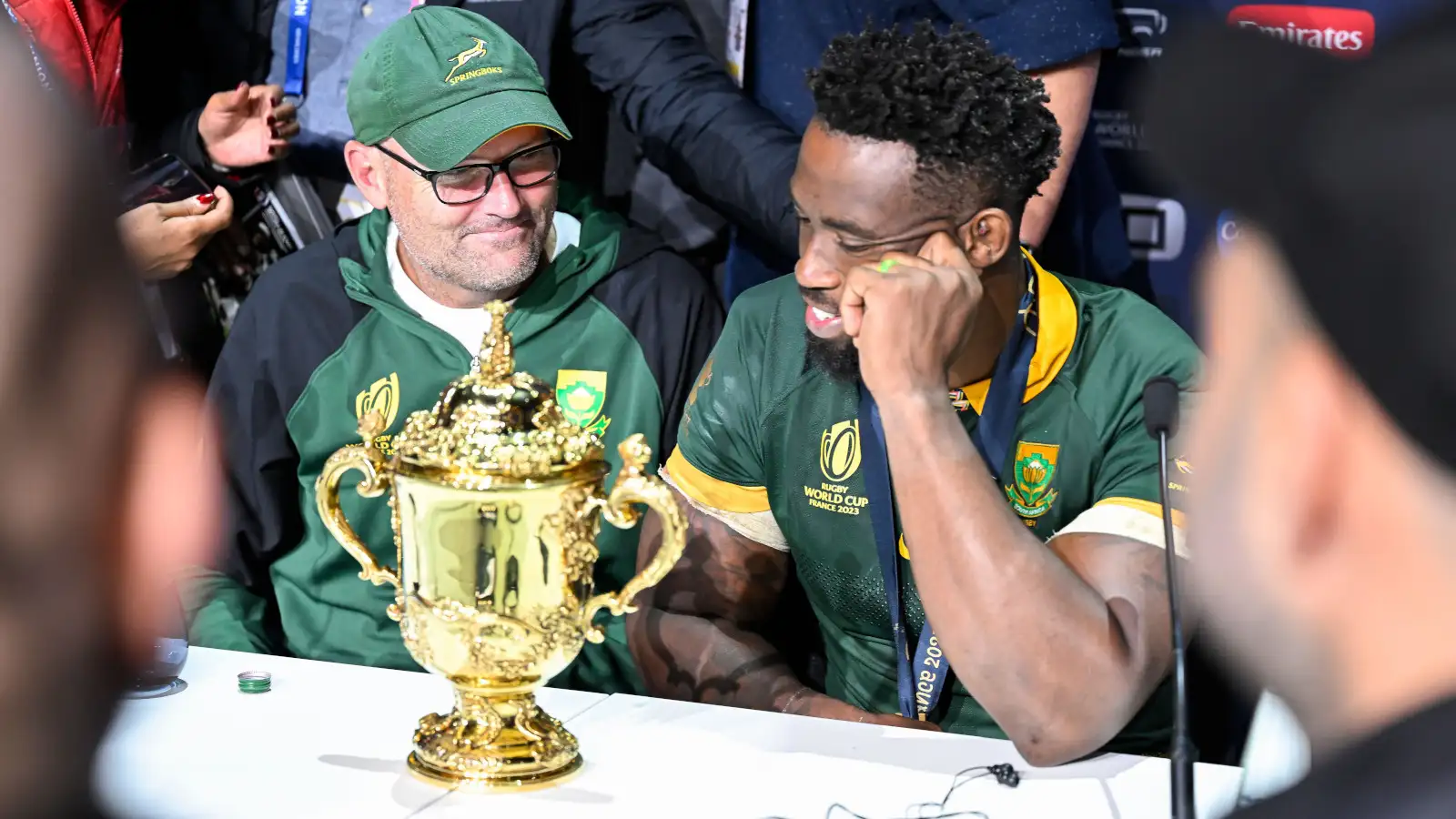Law discussion: Comparing Sam Cane and Siya Kolisi’s tackle offences in the Rugby World Cup Final

Sam Cane tackles Jesse Kriel while Siya Kolisi makes his hit on Ardie Savea.
There’s little doubt as to what dominated the headlines in the Rugby World Cup Final, but Argentina produced a memorable moment outside those as well…
The Cane/Kolisi comparison
So, one red card, one not. Clear differences?
To be fair, most have accepted these decisions as correct, but there is so much nuance here that it is worth reviewing simply to understand better just how difficult this must be for players.
Sam Cane, having rushed up in defence, is retreating again when Jesse Kriel receives the ball and steps to his right, starting a run towards the retreating Cane. It is a moment of chaos. Kriel has just picked up a poor pass which went to ground, after New Zealand had botched a line-out. Defenders are all around him on all sides, the attack is not in formation. Kriel steps and goes, looking for any form of space.
Cane reacts as only a good player should, he braces for a tackle, which he makes, clearly standing a little high but just as clearly wrapping his arms. In real time it looks a little upright, but it happens so fast, while neither player seems particularly dominant in the collision; Cane is perhaps rocked back slightly. Kriel does not stay down. He gets up almost instantly, takes his place in the defensive line, chases a kick, chases the kick back.
When the game is next stopped, Kriel does get a little magic sponge treatment, although the physio is looking more at his jaw than asking him to count fingers. It all seems innocuous.
The TMO flags it however. And in slow motion, it’s easy to see why. Cane is not stooped or bent at the waist, while the first point of contact between the two is between Cane’s shoulder and Kriel’s head.
The process of analysis is here, for reference.
Going through the process:
1 – Unquestionably there is head contact
2 – Foul play? We’ll come to this.
3 – Degree of danger was pretty high. A shoulder to the jaw with force is never a good thing.
4 – Mitigation? Also worth looking at.
So, foul play. Law 9.13 states that “A player must not tackle an opponent… dangerously. Dangerous tackling includes, but is not limited to, tackling or attempting to tackle an opponent above the line of the shoulders.
Certainly under this definition, Cane has committed foul play. And, under the process questions on page three, it would be said to have been avoidable, as Cane stayed upright. Unfortunately for him, he did move towards the contact, positioning himself to take it, shoulder forward.
Finally, to mitigation. It’s worth pointing out that if you freeze-frame the pair at the point of contact, neither are upright. Kriel’s body is on about a 30-degree angle from the vertical, enough of a stoop that his shin is almost parallel to the ground, while he is moving forward headfirst. Cane is also away from the upright, a few degrees less. The position of Kriel makes head contact almost unavoidable unless Cane manages to bend over almost double. Moreover, the force of the contact lifts Cane from the ground, reflecting both that the hit was not dominant and that Kriel simply had a better body position for the contact.
Mitigation is a close call, but we do think it is there. Most pertinently, in the context of what was happening in the game in those seconds: all disorganised, all reactive, all open, it’s remarkably tough to impose upon players the same sort of expectations for tackles that you could in a regulation phase of possession.
And what does count as a sudden drop in height? Some napkin maths: if Kriel, at 1m86 vertical, is on a 30-degree angle he is now 1m60 tall. Take off another 30cm for his head and neck and the contact point permissible is below 1m30. You’re asking Cane, all 1m89 of him, to assess among the chaos that he needs to get 60cm down in tenths of a second. It’s a heck of an ask, not least considering also that if he does manage this, his head and neck are likely to be met by the full force of the onward-rushing Kriel’s forearms.
So we do think mitigation was there. But it’s close, and requires significantly more empathy than the box-tickers making these rules currently allow.
https://twitter.com/Braveheart_NZ/status/1718467216365297801
As for Siya Kolisi, he was treading a very fine line.
New Zealand once again overthrow a line-out, although this one is more intentional. Ardie Savea catches the ball and is wrapped up by Duane Vermeulen. Kolisi, spying an opportunity for a good hit, stoops and thunders into Savea, knocking him backwards with enough force that the All Black captain bounces out of the contact. Savea is treated for a bit of claret from the nose. Moments later, the TMO is on the phone…
Same process:
1 – Head contact: yes
2 – Foul play: Again, we’ll look at this
3 – Degree of danger: it was a heavy impact. High
4 – Mitigation: Again, worth a deeper dive.
Back to Law 9, but this time Law 9.16, which says “A player must not charge or knock down an opponent carrying the ball without attempting to grasp that player.”
Does Kolisi grasp? The arm that makes contact is tucked in classic shoulder charge position. The other arm does wrap itself towards Savea, however. So which arm do you acknowledge here? It is the tucked arm which dictates the contact and the force thereof, and tucked arms have long since been used of an indicator as to how much a player is grasping, or wrapping, in a tackle, as opposed to charging. It’s close, but yes, this tucked arm is indicative of a charge, and thus an illegal tackle.
Mitigation? It’s there. The contact is not direct to the head, but is rather caused by the head snapping forward as the body is moved forcefully back. Kolisi is also bent close to double; it’s unreasonable for him to be much lower. Finally, Savea is not master of his own body movements, he is being dragged lower by Duane Vermeulen, something which Kolisi, at speed, is unlikely to have taken into account.
But he’s a lucky boy. The tackle was delivered at full dominant force. All it needed was Savea to be centimetres further towards Kolisi, or centimetres lower and we’d have been talking a fearsome head contact. The tackle was not outside the boundaries of reckless, nor fully legal. In many ways, it was worse than Cane’s. A yellow card was the correct decision as the head contact was incidental, but boy, was it close.
But the overall feeling is that Cane ended up extremely unlucky, consigned now to history as the first player to be red-carded in a World Cup Final mostly because of the misfortune of body positions and contact points, despite making a tackle less malign than his counterpart’s. Such are the margins, and such are the vagaries of head contact assessments.
A process is there, but it is dreadfully lacking in empathy for players playing a physical game at a speed which we on the sidelines can only marvel at. As Ian Foster said in the wake of it all: “The game has got a few issues it needs to sort out.” This is very obviously one of them.
Safety at line-outs
You all probably, as I did, marvelled at the line-out steal and athletic prowess of Juan Martin Gonzalez and his two lifters/chuckers, who heaved the former more than 2m into the air to pluck out an English throw.
Great stuff. Unfortunately probably illegal. It’s a little-known law, but Law 18.29.c states that players may “lift or support a team-mate (in a line-out). Players who do so must lower that player to the ground safely as soon as the ball is won by either team.”
The question is whether Gonzalez is indeed safe. He does stay well upright, which helps. But all it needs is one slightly out-of-kilter knee or ankle and he’s done for a year. High-risk stuff, but safe? Safe is being brought down securely by your lifters, not left to freefall 2m!
Gonzalez would probably insist it was safe, as I myself once did when hoisted up and set free in mid-air in similar fashion many years ago, but the referee that day was merciless. Others have also been so since. And should this tactic start to proliferate, expect an eventual clampdown along these lines.
READ MORE: Loose Pass: Rugby World Cup’s grand finale and the rushed onset of everything else



